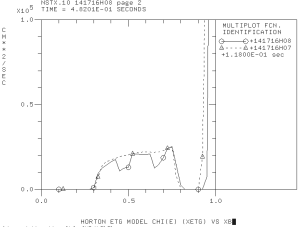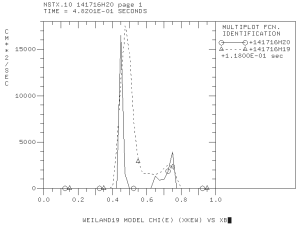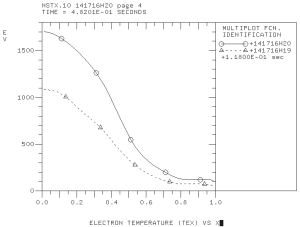Several short PTRANSP simulations are performed to test the effect of the ExB flow shear on Weiland (ITG/TEM) and DRIBM diffusivities. The PTRANSP code has been run for a very short time to ensure that the plasma profiles do not change significantly from the experimental profiles. This choice of the PTRANSP parameters will allow direct comparison of the effective diffusivities, computed using the predictive transport models, with the diffusivities obtained in an interpretive TRANSP runs. [The TRANSP code does not support running predictive transport models when it runs in the interpretive mode.]
I used the following PTRANSP parameters in my simulation:
TINIT=0.482 !**** START TIME
FTIME=0.48201 !**** STOP TIME
DTMINT=4.e-6
DTMAXB=1.e-5
DTMAXT=1.e-5
DTINIT=1.e-5
TBONMIN=0.80 ! !**** MINIMUM BEAM TURN ON TIME
For the first set of simulations the start time was TINIT=0.364 and for the second set the start time was TINIT=0.482. For the both sets, the simulations run for 1e-5 sec. There were no sources in these simulations enabled. The objective was to estimate the predictive diffusivities for the experimental profiles and to validate some trends in the diffusivity profiles between the two time slices.
I found that the that the ETG diffusivities change very little between the two time slices.  The result is somewhat unexpected because the plasma profiles are rather different:
The result is somewhat unexpected because the plasma profiles are rather different:
While the electron density gradients change very little, there is a large increase of electron temperature gradient in the region from  to
to  . We assume that there is almost no flow shear effect in the ETG diffusivities and the ETG model does not include the ExB flow shear effect.
. We assume that there is almost no flow shear effect in the ETG diffusivities and the ETG model does not include the ExB flow shear effect.
DIII-D 132014
&tbl_param ! (anomalous) turbulence diffusion
tbl_diffusion_on=1 ! 0: no turbulence diffusion, 1: simple turbulence diffusion
tbl_diffusion_mode=3 ! 1 = random walk model, 2 = advection-diffusion model
! mode=2 enables separate control of particle and heat diffusion
tbl_stop_time=500000 ! Stop the turbulence diffusion
tbl_period = 1 ! frequency of calling turbulence diffusion and fmcfm_call
tbl_d_profile_on=-1 ! 1: spatially varying D_turb profile (tanh), 0: spatially constant profile in pedestal region
tbl_slope_on=0 ! D_turb turned on only within finite poloidal angles (+45 deg) around outside midplane
tbl_d_profile_psicen=0.93D0 ! D_turb profile center
tbl_d_profile_psiwid=0.02D0 ! D_turb profile full width
tbl_d_profile_psicen2=0.999D0 ! D_turb profile center
tbl_d_profile_psiwid2=-0.01D0 ! D_turb profile full width
! particle diffusivities (random walk diffusion coefficients)
tbl_D_coeff_in=0.2D0 ! m^2/sec, inside (pedestal top) value of D_turb
tbl_D_coeff=0.03D0 ! m^2/sec, outside (pedestal bottom) value of D_turb
tbl_D_coeff2=0.6D0 ! m^2/sec, D_turb for outside of separatrix (SOL+private flux region)
! ion thermal diffusivities
tbl_therDi_coeff_in=.070D0 ! m^2/sec, inside (pedestal top) value of thermal D_turb for ions
tbl_therDi_coeff=-0.050D0 ! m^2/sec, outside (pedestal bottom) value of thermal D_turb for ions
tbl_therDi_coeff2=0.9D0 ! m^2/sec, thermal D_turb for outside of separatrix (SOL+private flux region) for ions
! electron thermal diffusivities
tbl_therDe_coeff_in=0.8D0 ! m^2/sec, inside (pedestal top) value of thermal D_turb for electrons
tbl_therDe_coeff=-0.1D0 ! m^2/sec, outside (pedestal bottom) value of thermal D_turb for electrons
tbl_therDe_coeff2=0.9D0 ! m^2/sec, thermal D_turb for outside of separatrix (SOL+private flux region) for electrons



DIII-D 132016
&tbl_param ! (anomalous) turbulence diffusion
tbl_diffusion_on=1 ! 0: no turbulence diffusion, 1: simple turbulence diffusion
tbl_diffusion_mode=3 ! 1 = random walk model, 2 = advection-diffusion model
! mode=2 enables separate control of particle and heat diffusion
tbl_stop_time=500000 ! Stop the turbulence diffusion
tbl_period = 1 ! frequency of calling turbulence diffusion and fmcfm_call
tbl_d_profile_on=-1 ! 1: spatially varying D_turb profile (tanh), 0: spatially constant profile in pedestal region
tbl_slope_on=0 ! D_turb turned on only within finite poloidal angles (+45 deg) around outside midplane
tbl_d_profile_psicen=0.94D0 ! D_turb profile center
tbl_d_profile_psiwid=0.02D0 ! D_turb profile full width
tbl_d_profile_psicen2=0.999D0 ! D_turb profile center
tbl_d_profile_psiwid2=-0.01D0 ! D_turb profile full width
! particle diffusivities (random walk diffusion coefficients)
tbl_D_coeff_in=0.13D0 ! m^2/sec, inside (pedestal top) value of D_turb
tbl_D_coeff=0.04D0 ! m^2/sec, outside (pedestal bottom) value of D_turb
tbl_D_coeff2=0.3D0 ! m^2/sec, D_turb for outside of separatrix (SOL+private flux region)
! ion thermal diffusivities
tbl_therDi_coeff_in=0.1D0 ! m^2/sec, inside (pedestal top) value of thermal D_turb for ions
tbl_therDi_coeff=-0.05D0 ! m^2/sec, outside (pedestal bottom) value of thermal D_turb for ions
tbl_therDi_coeff2=0.7D0 ! m^2/sec, thermal D_turb for outside of separatrix (SOL+private flux region) for ions
! electron thermal diffusivities
tbl_therDe_coeff_in=0.25D0 ! m^2/sec, inside (pedestal top) value of thermal D_turb for electrons
tbl_therDe_coeff=-0.05D0 ! m^2/sec, outside (pedestal bottom) value of thermal D_turb for electrons
tbl_therDe_coeff2=0.7D0 ! m^2/sec, thermal D_turb for outside of separatrix (SOL+private flux region) for electrons
/



DIII-D 132017
&tbl_param ! (anomalous) turbulence diffusion
tbl_diffusion_on=1 ! 0: no turbulence diffusion, 1: simple turbulence diffusion
tbl_diffusion_mode=3 ! 1 = random walk model, 2 = advection-diffusion model
! mode=2 enables separate control of particle and heat diffusion
tbl_stop_time=500000 ! Stop the turbulence diffusion
tbl_period = 1 ! frequency of calling turbulence diffusion and fmcfm_call
tbl_d_profile_on=-1 ! 1: spatially varying D_turb profile (tanh), 0: spatially constant profile in pedestal region
tbl_slope_on=0 ! D_turb turned on only within finite poloidal angles (+45 deg) around outside midplane
tbl_d_profile_psicen=0.91D0 ! D_turb profile center
tbl_d_profile_psiwid=0.02D0 ! D_turb profile full width
tbl_d_profile_psicen2=0.995D0 ! D_turb profile center
tbl_d_profile_psiwid2=-0.01D0 ! D_turb profile full width
! particle diffusivities (random walk diffusion coefficients)
tbl_D_coeff_in=0.13D0 ! m^2/sec, inside (pedestal top) value of D_turb
tbl_D_coeff=0.015D0 ! m^2/sec, outside (pedestal bottom) value of D_turb
tbl_D_coeff2=0.3D0 ! m^2/sec, D_turb for outside of separatrix (SOL+private flux region)
! ion thermal diffusivities
tbl_therDi_coeff_in=.1D0 ! m^2/sec, inside (pedestal top) value of thermal D_turb for ions
tbl_therDi_coeff=0.001D0 ! m^2/sec, outside (pedestal bottom) value of thermal D_turb for ions
tbl_therDi_coeff2=0.5D0 ! m^2/sec, thermal D_turb for outside of separatrix (SOL+private flux region) for ions
! electron thermal diffusivities
tbl_therDe_coeff_in=0.35D0 ! m^2/sec, inside (pedestal top) value of thermal D_turb for electrons
tbl_therDe_coeff=-0.1D0 ! m^2/sec, outside (pedestal bottom) value of thermal D_turb for electrons
tbl_therDe_coeff2=0.9D0 ! m^2/sec, thermal D_turb for outside of separatrix (SOL+private flux region) for electrons
/



DIII-D 132018
&tbl_param ! (anomalous) turbulence diffusion
tbl_diffusion_on=1 ! 0: no turbulence diffusion, 1: simple turbulence diffusion
tbl_diffusion_mode=3 ! 1 = random walk model, 2 = advection-diffusion model
! mode=2 enables separate control of particle and heat diffusion
tbl_stop_time=500000 ! Stop the turbulence diffusion
tbl_period = 1 ! frequency of calling turbulence diffusion and fmcfm_call
tbl_d_profile_on=-1 ! 1: spatially varying D_turb profile (tanh), 0: spatially constant profile in pedestal region
tbl_slope_on=0 ! D_turb turned on only within finite poloidal angles (+45 deg) around outside midplane
tbl_d_profile_psicen=0.89D0 ! D_turb profile center
tbl_d_profile_psiwid=0.02D0 ! D_turb profile full width
tbl_d_profile_psicen2=0.995D0 ! D_turb profile center
tbl_d_profile_psiwid2=-0.01D0 ! D_turb profile full width
! particle diffusivities (random walk diffusion coefficients)
tbl_D_coeff_in=0.05D0 ! m^2/sec, inside (pedestal top) value of D_turb
tbl_D_coeff=0.002D0 ! m^2/sec, outside (pedestal bottom) value of D_turb
tbl_D_coeff2=1D0 ! m^2/sec, D_turb for outside of separatrix (SOL+private flux region)
! ion thermal diffusivities
tbl_therDi_coeff_in=0.5D0 ! m^2/sec, inside (pedestal top) value of thermal D_turb for ions
tbl_therDi_coeff=0.001D0 ! m^2/sec, outside (pedestal bottom) value of thermal D_turb for ions
tbl_therDi_coeff2=2.0D0 ! m^2/sec, thermal D_turb for outside of separatrix (SOL+private flux region) for ions
! electron thermal diffusivities
tbl_therDe_coeff_in=.8D0 ! m^2/sec, inside (pedestal top) value of thermal D_turb for electrons
tbl_therDe_coeff=-0.07D0 ! m^2/sec, outside (pedestal bottom) value of thermal D_turb for electrons
tbl_therDe_coeff2=0.2D0 ! m^2/sec, thermal D_turb for outside of separatrix (SOL+private flux region) for electrons
/































